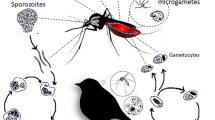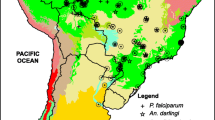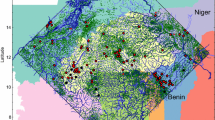Abstract
With climate warming, malaria in humans and birds at upper elevations is an emerging infectious disease because development of the parasite in the mosquito vector and vector life history are both temperature dependent. An enhanced-mosquito-movement model from climate warming predicts increased transmission of malaria at upper elevation sites that are too cool for parasite development in the mosquito vector. We evaluate this model with avian malaria (Plasmodium relictum) at 1,900-m elevation on the Island of Hawaii, with air temperatures too low for sporogony in the vector (Culex quinquefasciatus). On a well-defined site over a 14-year period, 10 of 14 species of native and introduced birds became infected, several epizootics occurred, and the increase in prevalence was driven more by resident species than by mobile species that could have acquired their infections at lower elevations. Greater movement of infectious mosquitoes from lower elevations now permits avian malaria to spread at 1,900 m in Hawaii, in advance of climate warming at that elevation. The increase in malaria at upper elevations due to dispersal of infectious mosquitoes is a real alternative to temperature for the increased incidence of human malaria in tropical highlands.





Similar content being viewed by others
References
Ahumada JA, LaPointe D, Samuel MD (2004) Modeling the population dynamics of Culex quinquefasciatus (Diptera: Culicidae), along an elevational gradient in Hawaii. J Med Entomol 41(6):1157–1170
Atkinson CT, LaPointe DA (2009) Introduced avian diseases, climate change, and the future of Hawaiian honeycreepers. J Avian Med Surg 23(1):53–63
Atkinson CT, Samuel MD (2010) Avian malaria Plasmodium relictum in native Hawaiian forest birds: epizootiology and demographic impacts on apapane Himotione sanguinea. J Avian Biol 41(4):357–366
Atkinson CT, Woods KL, Dusek RJ, Sileo LS, Iko WM (1995) Wildlife disease and conservation in Hawaii: pathogenecity of avian malaria (Plasmodium relictum) in experimentally infected iiwi (Vestiaria coccinea). Parasitology 111(Suppl):S59–S69
Baillie S, Gudex-Cross D, Barraclough R, Blanchard W, Brunton D (2012) Patterns in avian malaria at founder and source populations of an endemic New Zealand passerine. Parasitol Res 111(5):2077–2089. doi:10.1007/s00436-012-3055-y
Beadell JS et al (2006) Global phylogeographic limits of Hawaii’s avian malaria. Proc R Soc B Biol Sci 273(1604):2935–2944
Benning TL, LaPointe D, Atkinson CT, Vitousek PM (2002) Interactions of climate change with biological invasions and land use in the Hawaiian Islands: modeling the fate of endemic birds using a geographic information system. Proc Natl Acad Sci U S A 99(22):14246–14249
el Samani FZ, Willett WC, Ware JH (1987) Nutritional and socio-demographic risk indicators of malaria in children under five: a cross-sectional study in a Sudanese rural community. J Trop Med Hyg 90(2):69–78
Epstein PR, Diaz HF, Elias S et al (1998) Biological and physical signs of climate change: focus on mosquito-borne diseases. Bull Am Meteorol Soc 79(3):409–417
Feldman RA, Freed LA, Cann RL (1995) A PCR test for avian malaria in Hawaiian birds. Mol Ecol 4(6):663–673
Ferrer E, García-Navas V, Sanz J, Ortego J (2012) Molecular characterization of avian malaria parasites in three Mediterranean blue tit (Cyanistes caeruleus) populations. Parasitol Res 111(5):2137–2142. doi:10.1007/s00436-012-3062-z
Freed LA (2001) Significance of old-growth forest to the Hawaii akepa. Stud Avian Biol Ser 22:173–184
Freed LA, Cann RL (2006) DNA quality and accuracy of avian malaria PCR diagnostics: a review. Condor 108(2):459–473
Freed LA, Cann RL (2009) Negative effects of an introduced bird species on growth and survival in a native bird community. Curr Biol 19(20):1736–1740
Freed LA, Cann RL (2012a) Changes in timing, duration and symmetry of molt are associated with extensive decline of Hawaiian forest birds. PLoS One 7:e29834
Freed LA, Cann RL (2012b) Increase of an introduced bird competitor in old-growth forest associated with restoration. NeoBiota 13:43–60
Freed LA, Cann RL (2013) Females lead population collapse of the endangered Hawaii creeper. PLoS One 8:e67914
Freed LA, Cann RL, Goff ML, Kuntz WA, Bodner GR (2005) Increase in avian malaria at upper elevation in Hawaii. Condor 107(4):753–764
Freed LA, Fretz JS, Medeiros MC (2007) Adaptation in the Hawaii akepa to breed and moult during a seasonal food decline. Evol Ecol Res 9:157–167
Freed LA, Medeiros MC, Bodner GR (2008) Explosive increase in ectoparasites in Hawaiian forest birds. J Parasitol 94(5):1009–1021
Giambelluca TW, Diaz HF, Luke MSA (2008) Secular temperature changes in Hawaii. Geophys Res Lett 35(12), L12702
Goff ML, van Riper IIIC (1980) Distribution of mosquitoes (Diptera:Culicidae) on the east flank of Mauna Loa Volcano, Hawaii. Pac Insects 22:178–188
Griner LA (1974) Avian malaria in penguins. Adv Vet Sci Comp Med 18:251–271
Harvell CD et al (2002) Climate warming and disease risks for terrestrial and marine biota. Science 296(5576):2158–2162
Hay SI et al (2002) Climate change and the resurgence of malaria in the East African highlands. Nature 415(6874):905–909
Hayworth AM, van Riper IIIC, Weathers WW (1987) Effects of Plasmodium relictum on the metabolic rate and body temperature in canaries (Serinus canarius). J Parasitol 73(4):850–853
Howe L, Castro I, Schoener E, Hunter S, Barraclough R, Alley M (2012) Malaria parasites (Plasmodium spp.) infecting introduced, native and endemic New Zealand birds. Parasitol Res 110(2):913–923. doi:10.1007/s00436-011-2577-z
Illera J, Emerson B, Richardson D (2008) Genetic characterization, distribution and prevalence of avian pox and avian malaria in the Berthelot’s pipit (Anthus berthelotii) in Macaronesia. Parasitol Res 103(6):1435–1443. doi:10.1007/s00436-008-1153-7
Jarvi SI et al (2003) Detection of avian malaria (Plasmodium spp.) in native land birds of American Samoa. Conserv Genet 4(5):629–637
Jones HI, Shellam GR (1999a) Blood parasites in penguins, and their potential impact on conservation. Mar Ornithol 27:181–184
Jones HI, Shellam GR (1999b) The occurrence of blood-inhabiting protozoa in captive and free-living penguins. Polar Biol 21(1):5–10
Kay BH, Farrow RA (2000) Mosquito (Diptera: Culicidae) dispersal: implications for the epidemiology of Japanese and Murray Valley encephalitis viruses in Australia. J Med Entomol 37(6):797–801
Keyghobadi N, LaPointe D, Fleischer RC, Fonsecda DM (2006) Fine-scale population genetic structure of a wildlife disease vector: the southern house mosquito on the island of Hawaii. Mol Ecol 15(13):3919–3930
Kovats RS, Campbell-Lendrum DH, McMichael AJ, Woodward A, Cox JSH (2001) Early effects of climate change: do they include changes in vector-borne disease. Philos T Roy Soc B 356(1411):1057–1068
Kuntz WA (2008) The importance of individual behavior to life history and conservation: breeding and movement biology in the iiwi (Vestiaria coccinea). University of Hawaii at Manoa
Lafferty KD (2009) The ecology of climate change and infectious diseases. Ecology 90(4):888–900
LaPointe DA (2008) Dispersal of Culex quinquefasciatus (Diptera: Culicidae) in a Hawaiian rain forest. J Med Entomol 45(4):600–609
LaPointe DA, Goff ML, Atkinson CT (2010) Thermal constraints to the sporogonic development and altitudinal distribution of avian malaria Plasmodium relictum in Hawaii. J Parasitol 96(2):318–324
Lerner HRL, Meyer M, James HF, Hofreiter M, Fleischer RC (2011) Multilocus resolution of phylogeny and timescale in the extant adaptive radiation of Hawaiian honeycreepers. Curr Biol 21(21):1838–1844
Lindsey SW, Martens WJM (1998) Malaria in the African highlands: past, present and future. Bull World Health Organ 76(1):33–45
Loevinsohn ME (1994) Climatic warming and increased malaria incidence in Rwanda. Lancet 343(8899):714–718
Martens WJM, Jetten TH, Rotmans J, Niessen LW (1995) Climate change and vector-borne diseases: a global modelling perspective. Glob Environ Chang 5(1):195–209
Matola YG, White GB, Magayuka SA (1987) The changed pattern of malaria endemicity and transmission at Amani in the eastern Usambara mountains, north-eastern Tanzania. J Trop Med Hyg 90(3):127–134
McCallum HI, Dobson AP (1995) Detecting disease and parasite threats to endangered species and ecosystems. Trends Ecol Evol 10(5):190–194
Mouchet J et al (1998) Evolution of malaria in Africa for the past 40 years: impact of climatic and human factors. J Am Mosq Contr Assoc 14(2):121–130
Nullet D, Sanderson M (1993) Radiation and energy balances and air temperature. In: Sanderson M (ed) Prevailing trade winds. University of Hawaii Press, Honolulu, pp 37–55
Ortego J, Calabuig G, Cordero P, Aparicio J (2007) Genetic characterization of avian malaria (Protozoa) in the endangered lesser kestrel, Falco naumanni. Parasitol Res 101(4):1153–1156. doi:10.1007/s00436-007-0575-y
Ostfeld RS (2009) Climate change and the distribution and intensity of infectious diseases. Ecology 90(4):903–905
Paaijmans KP, Read AF, Thomas MB (2009) Understanding the link between malaria risk and climate. Proc Natl Acad Sci U S A 106(33):13844–13849
Pascual M, Ahumada JA, Chaves LF, Rodo X, Bouma M (2006) Malaria resurgence in the East African highlands: temperature trends revisited. Proc Natl Acad Sci U S A 103(15):5829–5834
Patz JA (1998) Predicting key malaria transmission factors, biting and entomological inoculation rates, using modelled soil moisture in Kenya. Trop Med Int Health 3(10):818–827
Patz JA, Epstein PR, Burke TA, Balbus JM (1996) Global climate change and emerging infectious diseases. J Am Med Assoc 275(3):217–223
Patz JA, Campbell-Lendrum DH, Holloway T, Foley JA (2005) Impact of regional climate change on human health. Nature 438(7076):310–317
Peters W, Christian S, Jameson J (1958) Malaria in the highlands of Papua and New Guinea. Med J Aust 2:409–416
Pimm SL (1996) Lessons from a kill. Biodivers Conserv 5(9):1059–1067
Plowright RK, Sokolov SH, Gorman ME, Daszak P, Foley JE (2008) Causal inference in disease ecology: investigating drivers of disease emergence. Front Ecol Environ 6(8):420–429. doi:10.1890/070086
Ralph CJ, Fancy SG (1995) Demography and movements of apapane and iiwi in Hawaii. Condor 97(3):727–742
Reiter P (2001) Climate change and mosquito-borne disease. Environ Health Perspect 109(Supp. 1):141–161
Reiter P (2008) Global warming and malaria: knowing the horse before hitching the cart. Malar J 7(Suppl 1):S3
Reiter P et al (2004) Global warming and malaria: a call for accuracy. Lancet Infect Dis 4(6):323–324
Reynolds DR et al (1996) Atmospheric transport of mosquitoes in northeast India. Med Vet Entomol 10(2):185–186
Rogers DJ, Randolph SE (2000) The global spread of malaria in a future, warmer world. Science 289(5485):1763–1766
Rueda LM, Patel KJ, Axtell RC, Stinner RE (1990) Temperature-dependent development and survival rates of Culex quinquefasciatus and Aedes aegypti (Diptera: Culicidae). J Med Entomol 27(5):892–898
Rutar T, Salgueiro EJB, Maguire JH (2004) Introduced Plasmodium vivax malaria in a Bolivian community at an elevation of 2,300 meters. Am J Trop Med Hyg 70(1):15–19
Savage AF, Ariey F, Greiner EC (2005) A new species of Plasmodium from Malagasy vangas. J Parasitol 91(4):926–930
Schroeder T (1993) Climate controls. In: Sanderson M (ed) Prevailing trade winds: weather and climate in Hawaii. University of Hawaii Press, Honolulu, pp 12–36
Scott JM, Mountainspring S, Ramsey FL, Kepler CB (1986) Forest bird communities of the Hawaiian Islands: their dynamics, ecology, and conservation. Stud Avian Biol Ser 9:1–431
Service MW (1997) Mosquito (Diptera: Culicidae) dispersal—the long and short of it. J Med Entomol 34(6):579–588
Valkiūnas G, Zehtindjiev P, Hellgren O, Ilieva M, Iezhova T, Bensch S (2007) Linkage between mitochondrial cytochrome b lineages and morphospecies of two avian malaria parasites, with a description of Plasmodium (Novyella) ashfordi sp. nov. Parasitol Res 100(6):1311–1322. doi:10.1007/s00436-006-0409-3
van Riper IIIC, van Riper SG, Goff ML, Laird M (1986) The epizootiology and ecological significance of malaria in Hawaiian land birds. Ecol Monogr 56(4):327–344
VanderWerf EA (2004) Demography of Hawaii elepaio: variation with habitat disturbance and population density. Ecology 85(3):770–783
VanderWerf EA, Burt MD, Rohrer JL, Mosher SM (2006) Distribution and prevalence of mosquito-borne diseases in Oahu elepaio. Condor 108(4):770–777
VanderWerf EA, Young LC, Yeung NW, Carlon DB (2009) Stepping stone speciation in Hawaii’s flycatchers: molecular divergence supports new island endemics within the elepaio. Conserv Genet 11(4):1283–1298. doi:10.1007/s10592-009-9958-1
Ventim R, Ramos J, Osório H, Lopes R, Pérez-Tris J, Mendes L (2012) Avian malaria infections in western European mosquitoes. Parasitol Res 111(2):637–645. doi:10.1007/s00436-012-2880-3
Woodworth BL et al (2001) Breeding productivity and survival of the endangered Hawaii creeper in wet forest refuge on Mauna Kea, Hawaii. Stud Avian Biol Ser 22:164–172
Zhou G, Minakawa N, Githeko AK, Yan G (2004) Association between climate variability and malaria epidemics in the East African highlands. Proc Natl Acad Sci U S A 101(8):2375–2380
Acknowledgements
We appreciate funding from the John D. and Catherine T. MacArthur Foundation (World Environment and Resources Program, 8900287) and the National Center for Environmental Research (Science to Achieve Results, Environmental Protection Agency, R82-9093), and support from the Australian Research Council Discovery Project grant DB451402 (H. McCallum, principal investigator). We thank many students and interns for assistance in obtaining blood samples, in particular Joby Rohwer and Matt Burt for the Kalij pheasant samples. We also thank Dennis Higashiguchi and Mayee Wong for extracting DNA from the blood and Mayee Wong, Dawn Reding, and Kira Krend for assistance in diagnosing the DNA for the presence of malaria. Constructive comments were offered by F. Reed and K. Krend.
Author information
Authors and Affiliations
Corresponding author
Rights and permissions
About this article
Cite this article
Freed, L.A., Cann, R.L. Vector movement underlies avian malaria at upper elevation in Hawaii: implications for transmission of human malaria. Parasitol Res 112, 3887–3895 (2013). https://doi.org/10.1007/s00436-013-3578-x
Received:
Accepted:
Published:
Issue Date:
DOI: https://doi.org/10.1007/s00436-013-3578-x




